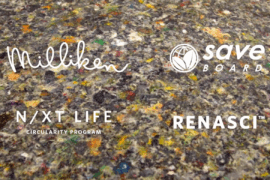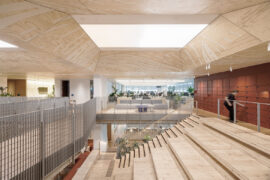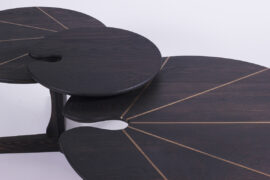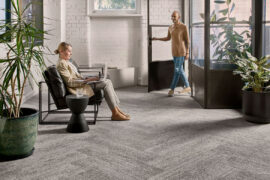As sustainability matures in the built environment, it’s no longer just about the tangible elements that can be deemed sustainable, increasingly social sustainability comes into play.

April 26th, 2018
There is no doubt that today, environmental sustainability is at the forefront of the minds of architects designing high-rise buildings. Ensuring that the ecological impact of a tall building is lessened; its energy efficiency to be high-quality as possible is of increasing urgency within our quickly expanding vertical cities.
But what about social sustainability? Does prioritising environmental consciousness mean that the quality of life of building tenants will be compromised? Can environmental sustainability indeed co-exist with social sustainability? And with growing attention being paid to our mental health and wellbeing, and the potentially dire outcomes of not looking after ourselves, can we design tall buildings that actually aid in boosting our moods and social lives?
These questions, and the varying answers they may bring about will be explored at this year’s Australian Smart Skyscrapers Summit, to be held in Sydney.
Domino Risch, principal interior designer at HASSELL and an upcoming panellist at the Summit, says that when we start to define sustainability in ways that extend beyond measuring energy use and material specifications, we can create skyscrapers and high-rise buildings that are environmentally and socially sustainable – particularly within workplace contexts.
“Research demonstrates that happy, healthy and engaged people are more productive and so I believe there is a very clear and strong link between sustainability, wellbeing and innovation that smart organisations are already capitalising on in their workplaces,” she adds.
Risch remarks that pleasing aesthetics have a surprising part to play within human-friendly high-rises, emphasising “that the role of beauty in our built environment is a highly underrated element, making a significant contribution to people’s psychological and mental wellbeing that is only just beginning to be understood.”
Dr Philip Oldfield, author of the upcoming book The Sustainable Tall Building: A Design Primer, says that we also need to be thinking about the types of communities that we are creating for individuals housed within tall buildings.
“What activities are available on the 20th floor? What spaces and places are for the community? We need to design better social and communal spaces at height, if the tower is to be a successful typology for the 21st Century,” Dr Oldfield, who will also be speaking at the Summit in June, states.
Arup’s Australasia Research Leader Alexandra Sinickas echoes this sentiment. “We must ask ourselves how our high-rises connect and contribute to the people and precinct around it and to the broader city systems – this is not just about making sure there’s good transit access to the office block, but also about connecting people within it.”
She emphasises that within a world filled with shifting work styles, there lies the opportunity to connect individuals who may not have otherwise crossed paths.
“In my office tower, we have an IP lawyer, a huge Australian industrial company, two architects and Arup. What are we missing by not having a space to meet, learn, and work together? As our working styles become more independent and sporadic, people are looking for connection.
Optimising social sustainability within a tall building, then, ties into redefining the various functions and features of the building itself – from its interior (and exterior) aesthetics, to the layout and inclusion of its communal areas. And in many cases, these functions happen to be just as environmentally conscious as they are human-friendly.
Sinickas says that “sustainability has matured in the last few decades into a design approach that provides social and economic benefit.” She points to cross-laminated tall timber structures, which Arup has been researching and prototyping, as prime examples of buildings that balance social sustainability with energy efficiency.
“We could soon see wooden buildings over 20 storeys in Switzerland and Austria, structures that absorb CO2 and have wonderful biophilic effects on the people living and working in them – this new generation of timber buildings promises to be taller and more sustainable than ever before.”
Sinickas names Arup’s latest project HAUT, set to be completed in 2019, and Austria’s LifeCycle Tower as two timber towers that are highly sustainable.
She will further outline some of Arup’s most sustainable projects at the 2018 Australian Smart Skyscrapers Summit, where she is set to analyse the relationship between tenant wellbeing, technology, and green solutions within high-rise contexts.
If we continue to work to understand the importance of interior layouts within a tall building, and how green solutions can often parallel tenant wellness, a more defined picture begins to emerge of what a socially and environmentally sustainable high-rise looks like.
With a sustained sense of awareness, we will move increasingly closer to a built environment filled with eco-friendly, socially sustainable buildings.
INDESIGN is on instagram
Follow @indesignlive
A searchable and comprehensive guide for specifying leading products and their suppliers
Keep up to date with the latest and greatest from our industry BFF's!

Welcomed to the Australian design scene in 2024, Kokuyo is set to redefine collaboration, bringing its unique blend of colour and function to individuals and corporations, designed to be used Any Way!

The undeniable thread connecting Herman Miller and Knoll’s design legacies across the decades now finds its profound physical embodiment at MillerKnoll’s new Design Yard Archives.

Gaggenau’s understated appliance fuses a carefully calibrated aesthetic of deliberate subtraction with an intuitive dynamism of culinary fluidity, unveiling a delightfully unrestricted spectrum of high-performing creativity.

As French-Lebanese Architect Lina Ghotmeh prepares for lectures in Melbourne and Sydney, we hear about the philosophy shaping her internationally celebrated practice.

Developed by Milliken in partnership with saveBOARD, Renasci™ is a breakthrough circular flooring product made from carpet and soft plastics waste – designed to be repeatedly recycled.

Reuse, resourcefulness and material transformations bring unexpected stories to Arup’s new Brisbane office, designed by Hassell.

The client’s brief was clear: create an environment that honoured FIN’s heritage while embracing its future. For Intermain, that meant rejecting the idea of the corporate, “boring” office and instead leaning into a space that would inspire, connect, and surprise.
The internet never sleeps! Here's the stuff you might have missed

The second installment in our three-part series on collaborations between the world’s best designers and the American Hardwood Export Council

The new Heritage Loom Collection weaves past and present together to capture the spirit of iconic fabric construction